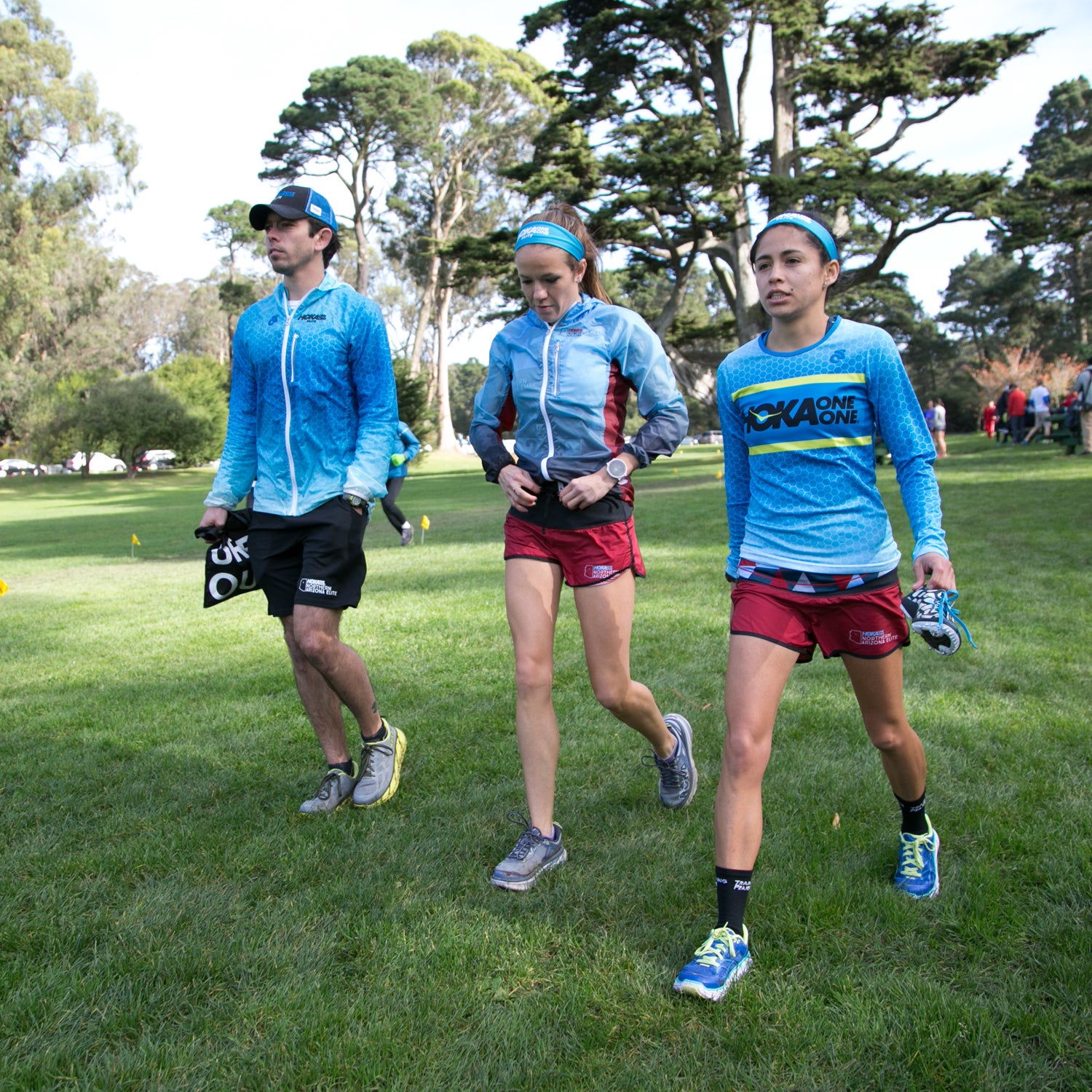Ben Rosario is something of a factotum in the distance running world. He was a collegiate All-American. He ran professionally for a few years, clocking 2:18 in the marathon and qualifying for the 2004 Olympic Trials. He was the special events director of the St. Louis Marathon, before opening his own running store. After selling the business and moving out to Flagstaff, Rosario started a professional running club known as , where he serves as head coach. The club, which is sponsored by Hoka One One, is home to some of the best runners in the country, a few of whom will be competing in next weekend’s Olympic Marathon trials.
We chatted with Rosario about the demands of elite-level marathon training, the significance of the Olympic Trials, and how the sport of running needs to do a better job of celebrating its top talent.
OUTSIDE: Who do you guys have running in the trials next weekend?
ROSARIO: We have four athletes. On the men’s side, we have , who’s run 2:12, Scott Smith, who’s run 2:14 and ran in the World Championships in Beijing, and we have Ben Bruce, who just ran 1:02:28 for the half a few weeks ago. And then, on the women’s side, we have , who debuted last year, in Houston, with 2:28. I think she’s the seventh seed going into the trials.
The marathon training cycle for a professional runner seems much shorter than for amateurs. Is that true? How long is a marathon training cycle for one of your athletes?
That’s totally accurate. We do twelve weeks and in the middle of those twelve weeks, we take a down week where we back off the mileage and don’t do any hard workouts. Because they just get so fit, so quick. They’ve run thousands of miles, so they just don’t take very long to get fit and we don’t want to get too fit, too quickly. You really have to space things out over those twelve weeks and make sure that you hit it right at the right time.
“In this sport, there’s a lot of, ‘Oh, well, just do it on your own.’ And I just don’t believe in that. I don’t think that’s a very professional way to do it.”
Many of the marathon training plans you find online, for amateurs, are about twenty weeks.
I think if you tried to go twenty weeks, it might really drag on. I like twenty weeks for a shorter race, like a 10K, because there are so many other energy systems we need to work and that gives us time. But in a marathon, you’re really only pounding one energy system so it just doesn’t take that long and these guys, again, they’re just so good that they get in shape pretty quickly.
What do you mean by “energy system”?
In the marathon, you’re only tapping into what I call the “high-end” aerobic system. In other words, to use some of the language people have heard before, you’re not really going into that VO2-max zone–that 10K-specific sort of zone. You’re certainly not going anaerobic. So really all you need to do, I mean not “all” but the majority of your work, basically needs to be very specific to this race, which means a lot of work at marathon pace or slightly faster so you can be super economical and efficient at that rhythm.
Speaking of rhythm, your athletes are about one week out from the trials. What does the last week look like for them, training-wise? Some coaching philosophies advise not to do anything hard in the last week before a marathon, while others object that this approach takes you out of the rhythm that you’ve established throughout your training.
I think I fall right in the middle. I want to stay in the rhythm, but obviously I want to back off. I want them super fresh for the race. You kind of trick the body into feeling normal, even though you back way off. So, if they’re used to running ten to twelve miles in the morning, four to six miles in the afternoon, all of a sudden you’ll make that eight and four. So you back off, but they still feel that rhythm. The week of the race, we always run two-by-three miles right at goal marathon pace. That’s usually our last workout.
Those easy three-by-twos, how many days prior to the race will that be?
It’ll be on Tuesday. The race is on Saturday, so we’ll have three pretty easy days before the race.
“The people inside the bubble are patting themselves on the back saying: ‘This is great. You see all these tweets? All this excitement about the trials?’ Yeah, from people who already know about it.”
Your club is known for its team atmosphere and training as a group. Is this part of larger coaching philosophy?
There are plenty of great examples out there of how to be a professional sports team. No matter how great the athletes are, they need a coach and they need structure. When the Lakers were winning titles, Phil Jackson didn’t just roll the basketballs out. They had practice and there was structure to what they did. And I think athletes need camaraderie and chemistry and all those things. So we meet every day to run together and they go to strength and conditioning together and, though I’m not the social director of the group, I like to keep tabs on things and make sure everyone is getting along. In this sport, there’s a lot of, ‘Oh, well, just do it on your own.’ And I just don’t believe in that. I don’t think that’s a very professional way to do it.
To play devil’s advocate, basketball is a team sport. Running is not. So why does the training together/chemistry element matter in running?
I think it’s about belief. We try to structure our group so that it’s very high level. Everybody is really, really good. So the bar is very high. So it has that effect where it’s like ‘Amy won a national title, so why can’t I win a national title? I train with her every day.’ Or, ‘Matt ran 1:01 in the half-marathon, so I know I can do that because I run with Matt.’ That’s the kind of momentum running as a group creates. It keeps you on your toes and you’re never satisfied because there’s always someone looking to best you.
Moving on to the Olympic Trials. A lot of the media coverage, so far as it exists, is about who might make the team. This seems to miss the fact that getting to the trials is a crowning achievement for the competitive amateur. Thoughts?
Those people are working full-time jobs. They’re getting up early in the morning, going to work all day, and then running again. It’s really impressive what they do. The commitment, in some ways, is greater than the pro athletes. And we need these people. We need these types of qualifiers for the sake of the event. In my opinion, the Olympic Trials marathon is the best showcase of distance running in this country, every four years. And it wouldn’t be that if we didn’t have a guy from St. Louis making it. And a guy from Cincinnati. And a gal from Richmond, or wherever it might be. We need these people from all over the country, because then the Richmond paper, and the Cincinnati paper, and the St. Louis paper cover the event. We need those fans. That girl from Richmond, we need her mom and dad, grandma and grandpa coming to the event, watching it, and then maybe becoming a fan of Shalane Flanagan or Kellyn Taylor, or whoever it might be.
Running is huge right now with record numbers signing up for marathons and half-marathons. We’re said to be in a “second running boom.” But for those who follow pro running in the U.S. it still feels like an esoteric interest. Why do you think that is?
I think that we made a huge mistake in this second running boom, as you say, in the mid-2000s when it really took off. I think we made a big mistake to think that promoting the professional side of the sport would somehow alienate the regular runner. It’s a very bizarre concept because it’s not true in any other sport. Can you imagine if Tennis Magazine put regular people on the cover? Or a basketball magazine just put a regular Y-league player on the cover instead of Lebron James? What kind of sense would that make? I played indoor soccer for fun when my running career was done, and I didn’t hate Cristiano Ronaldo because he was a great soccer player. If we want this boom to continue for years, we have to give people something to be inspired by. This applies to running store owners and magazine editors—anybody who is a gatekeeper for the sport. They need to get rid of the idea that promoting the professional side of the sport is dangerous and could hurt its mass appeal. It’s the exact opposite.
The lackluster media coverage of the trials seems to support what you just said.
The promotion of the trials has been weak. And I’ll tell you why. The people inside the bubble are patting themselves on the back saying: ‘This is great. You see all these tweets? All this excitement about the trials?’ Yeah, from people who already know about it. We have to get to the people who don’t know about it. We’ve got to reach outside of that. That’s what we’re not doing. We’re so locked inside this bubble of people that already know this stuff and we’ve got to get outside of that.
Could it just be that, at the end of the day, running is harder to market as a sport? Look at the spectacle of the Super Bowl. How can running compete with huge guys smashing into each other?
I don’t totally disagree, but let me ask you this. Imagine going to a football game but take away all the pomp and circumstance. Don’t play any music between plays. Don’t have any cheerleaders. Don’t have any flashing ads on the Jumbotron. Just have the game. How boring would that be? Those sports figured out long ago, and [Dallas Mavericks owner] Mark Cuban said this one time, that it’s not about the game. It’s about entertainment. And the powers that be in running have never figured that out. They’re always more focused on uniform rules.


